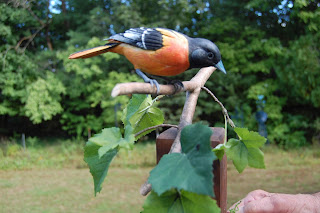In my yard, I know that a pair of cardinals
will always show up at dawn and dusk. I
know, too, that my neighborhood goldfinches prefer my old rusty thistle feeder to
my shiny new one. And I’ve learned that the
local chickadees recognize the sound of seed being poured into my feeders, and
they equate that sound to the proverbial dinner bell.
On any given day the same twelve
species of birds seem to arrive, feed and depart at the same time and in the
same manner. But because the “regulars”
are so predictable, it’s easy to notice when something new arrives. And every few winters, flocks of unusual
invaders from the north visit our feeders and bring new life to the yard.
This year seems to be one of those
years.
It started with reports of pine
siskins showing up at bird feeders around the state in November. Close
relatives of goldfinches, they have brown streaks on their belly and back that
distinguish them from the goldfinches, though they often show up at the feeders
together. I’ve only had a couple visit my feeders so far this year, but I have
high hopes for more as the winter progresses.
 |
| Red Crossbill by Sveinn Jonsson |
Siskins are among a group of birds –
including evening grosbeaks, common redpolls, and red and white-winged crossbills
– collectively called northern finches that typically spend their winters in
the extreme northern U.S. and throughout Canada feeding on pinecones and other
seeds. But every four or five years when the cones in the far north don’t
develop as usual, these birds travel south en masse in search of food.
Evening grosbeaks have been making
an appearance in the region this month, too, and they are getting birders
especially excited, since they are so seldom seen, even in good years for
northern finches. These large gold and black and white birds with huge beaks
are a memorable sight at birdfeeders, both for their beautiful appearance and
for their tendency to travel in large flocks.
They are particularly notable for
their voracious appetites. Most people who feed birds consider themselves lucky
to have a flock visit their yard. But
after a week or so, they may not feel so lucky after all. Like a house full of unexpected guests, a
flock of grosbeaks can quickly put a strain on your food budget.
Flocks of red crossbills have also
been observed wandering our region, though they seldom visit bird feeders so
they are a bit more difficult to see. But the unusual birds are worth searching
for. True to their name, the bill of a crossbill crosses: the upper mandible curves sharply downward
like that of a hawk, while the lower mandible curves upward. Although the beak appears deformed, this strange
adaptation evolved as a means of more easily opening pinecones.
The only one of the northern finches
I’m still looking for this winter is the common redpoll, which, despite its
name, isn’t common at all. Streaked with brown, they have a cranberry spot on
their forehead, a black chin, and a slightly rosy chest.
I have my fingers crossed that a
flock of redpolls will show up at my feeders in the coming weeks to give Rhode
Island the rare superfecta – four winter finches in one season. And then I’ll
start wondering who next year’s invading visitors will be.












